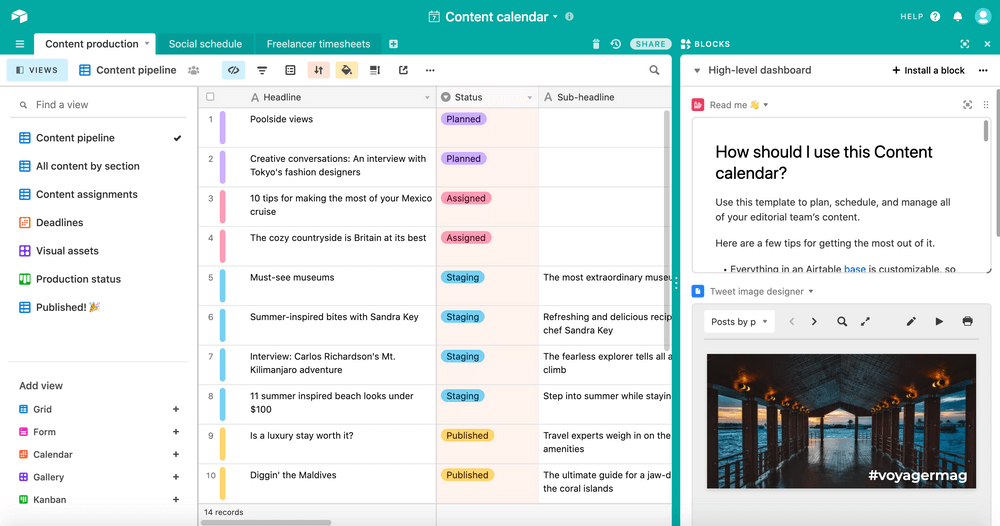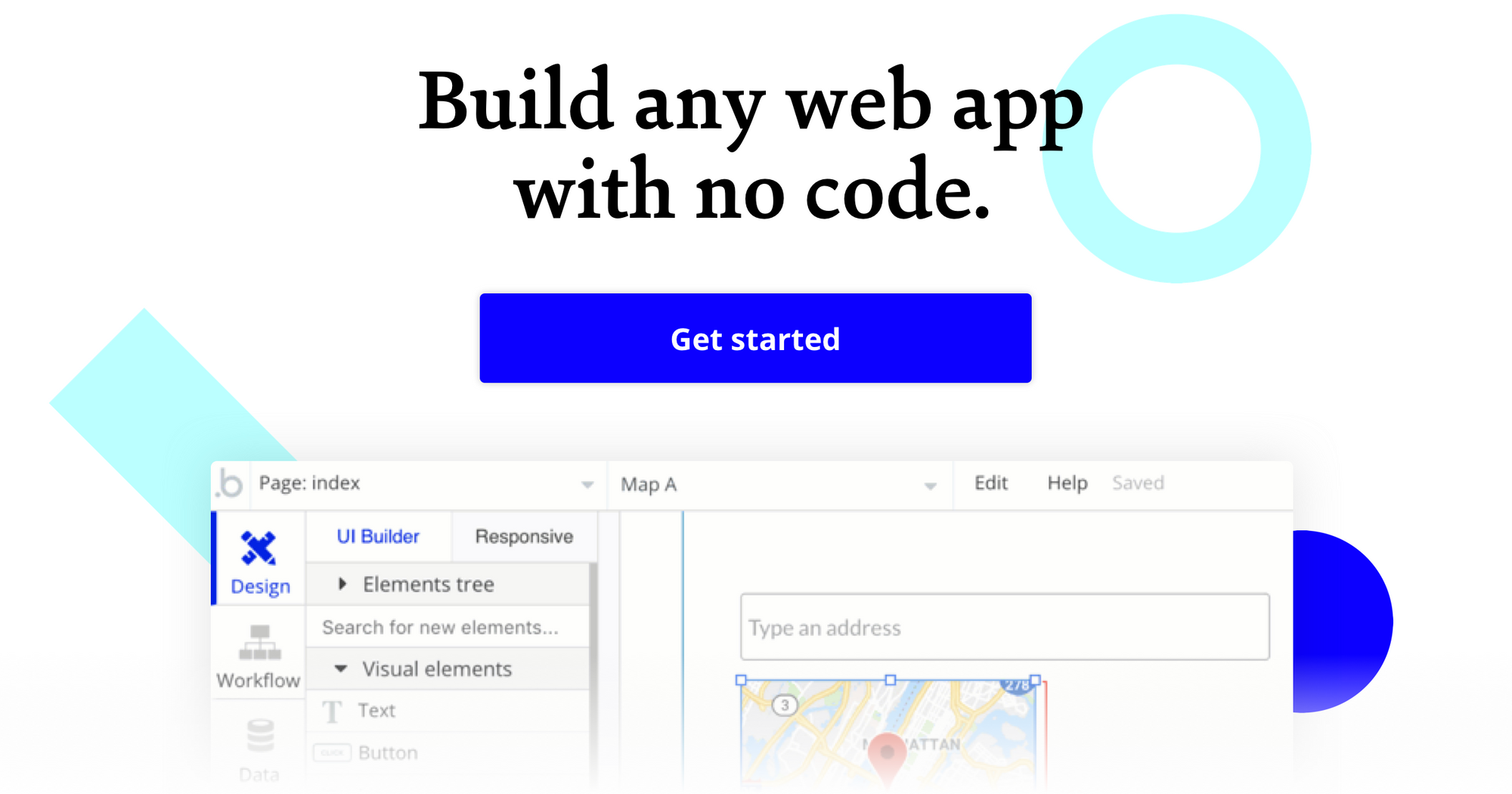At Bubble, we want to enable potential builders to create their ideas without code, so we are exploring and reviewing the many tools and software that enterprises might use to build apps.
What is Airtable?
A cloud-based collaboration service, Airtable is a spreadsheet-database hybrid tool that helps people organize information that can synchronize across multiple devices, which makes it a good platform for collaborating with your teammates.
To start building your Airtable base, you have three options: import a spreadsheet from Google Sheets or Excel, start from scratch, or choose a template that suits your specific needs. Whether you’re monitoring your startup’s new marketing campaign or keeping track of your pet’s medical history, Airtable’s templates enable you to quickly build apps that make it easier to manage your business or personal life.

While Airtable allows you to organize your information using spreadsheet-like grids, you are also free to arrange your data into galleries, calendars, and kanbans. And if you’re collecting data with a form, the responses will feed directly into Airtable. To customize your grids, you can add things like checkboxes, dropdowns, extended notes, and internal links to other Airtable spreadsheets.
Airtable also allows for integration with hundreds of third-party services, including LinkedIn, Slack, Twitter, and Evernote. To extend Airtable’s functionality further, you can create custom applications (known as blocks) and automate certain tasks, like sending a Slack message to the relevant team member whenever a new client submits a form.
And although Airtable is designed for people with no background in coding, experienced developers can utilize their programming skills to view data programmatically using Airtable’s API, as well as add custom-code functionality to rows in their Airtable base.
Who is Airtable for?
Airtable users include freelancers, nonprofits, startups, engineers, publishers, VC firms, and large tech companies. Tesla and WeWork are among their well-known clients.
Individuals can use Airtable to help with tasks like planning weddings and making shopping lists, whereas businesses and startups are able to use the spreadsheet-database hybrid tool to manage large amounts of information, track inventories, store customer information, and much more.
Airtable Cost and Pricing?
(Pricing model evaluation in USD: June 2020)
Airtable offers 4 pricing tiers: Free, Plus, Pro & Enterprise.
All plans include unlimited bases, email support, real-time collaboration and comment tools, as well as key Airtable features such as field type attachments, checkboxes, dropdowns, grids, calendars, forms, kanban, gallery views, and more. You can access Airtable on any iOS or Android device.
Free: With the free option, you receive 1200 records per base and 2GB of attachment space per base. You can see the past 2 weeks of revision history as well.
Plus: The Plus option costs $10/user per month (billed annually) or $12 (billed monthly). This plan comes with 5000 records per base, 5GB attachment space per base, and 6 months of revision and snapshot history.
Pro: The Pro option, which costs $20/user per month (billed annually) or $24 (billed monthly), comes with 50000 records per base, 20GB of attachment space per base, and 1 year of revision and snapshot history, as well as priority support and advanced features. With Pro, you have access to additional color and styling options, advanced calendar features, custom branded forms, personal and locked views, password and domain restricted shares, field and table editing permissions, and early access to new features.
Enterprise: To get a quote for an Enterprise plan, you need to set up a demo with the Airtable team, who will help you determine your specific needs. Enterprise plans come with 1000GB of attachment space per base and 3 years of revision and snapshot history, and you can work with the Airtable team to determine how many records per base your organization will need.
Besides receiving all of the benefits from the Pro option, Enterprise plans come with a dedicated customer success manager, individualized onboarding and training, and important admin features, including SAML-based single sign-on (SSO), federate company account, unlimited workspaces, payment by invoice, enterprise-wide admin panel, and enhanced deletion recovery.
Airtable vs. Bubble: A Comparison
How does the spreadsheet-database model of Airtable compare to a more comprehensive no-code platform Bubble?
Similarities between Airtable and Bubble:
Both Airtable and Bubble offer robust communities where people ask questions and offer suggestions.
Both allow for integration with third-party tools like Slack and Twitter.
Both Airtable and Bubble currently have a free plan option.
Both come with version control tools so that you can return to a previous iteration.
Both let you build apps from templates or from scratch.
Both can seamlessly integrate with platforms like Zapier.
The key differences between Airtable and Bubble are:
Internal Use vs. End Users: Airtable is designed for collaboration across multiple devices, which makes it a good choice for streamlining your team’s internal workflows. With the Pro and Enterprise pricing tiers, you can add personal views that hide your work from your teammates, or locked views that allow people to view your base but not edit it. Bubble equips businesses and startups with the necessary tools to build apps for internal use, as well as for apps with end users or customers.
Database Functionality: Airtable applies the features of a database to a spreadsheet, which makes it easy to organize and visualize data using gallery views, forms, tables, and much more.

Bubble comes with full database functionality built-in, and Bubble users are able to build things that are not possible with Airtable. With Bubble, you can create a full rental marketplace that resembles Airbnb, an interactive online learning platform, or a social network with upvoting features.
NOTE: You can also now integrate Airtable with your Bubble app using the new Airtable Plugin, which enables you to pull data from Airtable into Bubble, as well as update Airtable records from Bubble workflows.
Front-End Development: Unlike templated CMS platforms like Squarespace or Weebly, Bubble allows for pixel-perfect placement of any element and full freedom of front-end event and element triggers. While some customization is available with Airtable, in general, you must view your data using predetermined layouts such as grids, calendars, kanbans, galleries, and forms.
Alternatives to Airtable
Alternative no-code CMS platforms or tools that allow you to build a web application without code include the following tools:
If you want a tool that combines documents and spreadsheets to streamline your team's internal workflows, take a look at Coda.
If you need an enterprise-focused no-code tool, check out Betty Blocks, Salesforce Lightning, or Unqork.
If you’re looking for a platform that allows you to build and launch native or mobile apps, no-code tools like Adalo, Glide, or Thunkable are good options.
If you’re launching an ecommerce business and only require CMS and basic landing pages, then you can consider templated website hosts like Squarespace, Wix, or Weebly as alternatives.
If your project calls for full freedom over front and back-end elements (like building a full marketplace), or you need full backend database functionality built-in, no-code platforms like Bubble are a good alternative to Airtable.
If you’re starting a blog, and you need an open-source CMS platform with robust plugins that allow you to connect your frontend to a database, try WordPress.
About Bubble
Bubble is a leader in the no-code movement. Bubble offers a powerful point-and-click web editor and cloud hosting platform that allows users to build fully customizable web applications and workflows, ranging from simple prototypes to complex marketplaces, SaaS products, and more. Over 400,000 users are currently building and launching businesses on Bubble - some have gone on to participate in top accelerator programs, such as Y Combinator, and even raised $365M in venture funding. Bubble is more than just a product. We are a strong community of builders and entrepreneurs that are united by the belief that everyone should be able to create technology.
Join the no-code movement today.
Disclaimer: The goal of these reviews is to provide an honest, practical, differentiated comparison of features and educate readers on tools in the no-code ecosystem so that you can evaluate how these services fit together and serve your needs.





